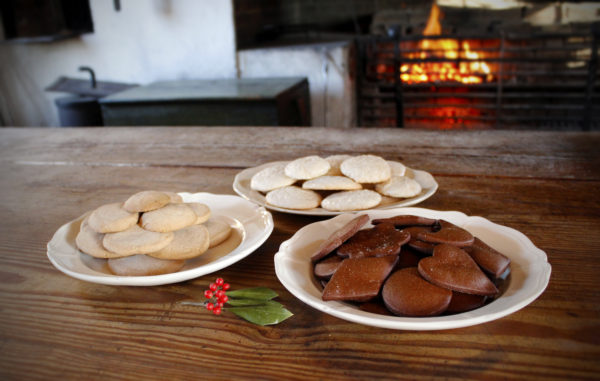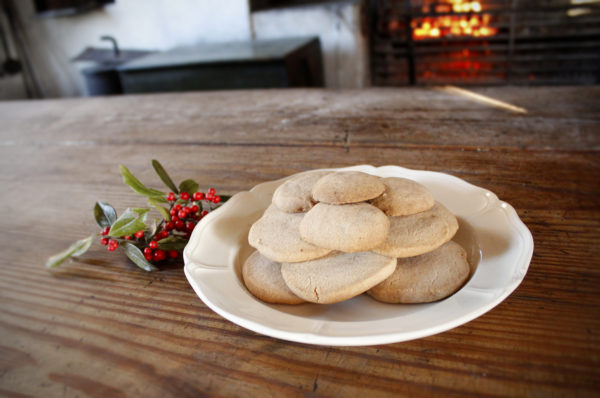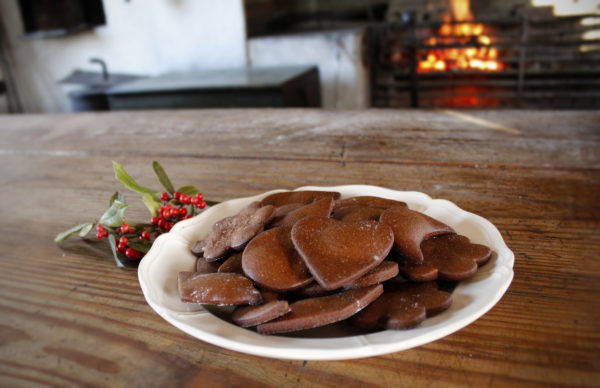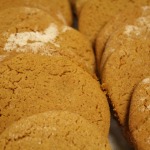
Today we call them cookies, but in the 18th century (and still today, if you’re British) they were known as “biscuits.” To give you a taste of colonial Virginia, we’ve teamed up with Historic Foodways Apprentice Tyler Wilson to bring you three different biscuit recipes, all with varying levels of difficulty, to try with your family this holiday season.
Before getting started, Tyler emphasized that cookies/biscuits were not synonymous with Christmas in Colonial America—although gingerbread did become more important around the holidays in the late 18th century. With the exception of Christmas Pie and 12th Night Cakes, Christmas was celebrated more with meals featuring large amounts of food rather than specific dishes.
Still, there are many delicious biscuit recipes to be found in 18th-century cookbooks, and ones we can use to connect with our colonial forebearers while also embracing modern holiday traditions. So grab your apron and preheat your oven. It’s time to make biscuits!
Sugar Biscuits

First up, we give you sugar biscuits. As Tyler explains, this is one of the “easiest biscuits in the Colonial repertoire,” making it a perfect choice for baking with youngsters. Here is the original recipe from Richard Briggs’ The English Art of Cookery, published in 1794:
“Take a pound and a half of fine flour, one pound of cold butter, half a pound of sugar, work all these well together into a paste, then roll it with the palms of your hands into round balls, and cut them with a thin knife into thin cakes, sprinkle a little flour on a sheet of paper, and put them on; prick them with a fork and bake them.”
As you can see from that very long, single sentence, recipes looked quite different in the 18th century. That’s because recipe books were published for people who already knew how to cook. “We’re accustomed to seeing recipes that are broken down into the simplest terms possible today, to make them accessible for all skill levels,” Tyler explains, “but in the 18th century, they were written for people who cooked for a living. They were also left purposefully vague, to allow readers to personalize dishes to taste.”
For those of you who are visual learners, or perhaps less comfortable tackling a single-sentence recipe, Tyler demonstrates how to make sugar biscuits in this video, which is followed by the modern adaptation of the recipe:
18th-Century Sugar Biscuits
Try your hand at this modern adaptation of a 1794 recipe for sugar biscuits.
- 4 ½ cups flour
- 2 sticks butter
- 1 cup sugar
- Cream butter and sugar together with your hands until light and fluffy. Add flour by degrees to the mixture. Remove the mixture by scraping with a spatula or knife and place on hard surface and knead until well mixed and smooth. Dough will be stiff.
- Form into four balls, the size of a tennis ball and reducing in size as you go until the smallest ball is about 1 ½ inches in diameter.
- Slice dough 1/4” thick with a sharp, smooth knife. Place on parchment paper or lightly greased cookie sheets.
- Bake at 350, 12-18 minutes until the centers of the large cakes are set when lightly pressed with your finger.
- After cooling, remove from cookie sheet. To form into a pyramid shape, use the larger cakes on the base, and stack the next smaller ones on top. Sift confectioner’s sugar on top (optional).
Gingerbread Biscuits

Next up, our “intermediate” recipe: gingerbread biscuits. As Tyler explains, this is one of the oldest English biscuits, dating to the 15th century. Interestingly, he notes that Queen Elizabeth I reportedly made gingerbread into the figures of foreign dignitaries. These taste a bit different than the gingerbread cakes found in the Raleigh Tavern; a bit spicier and richer. Although Tyler assures us you can easily add more or less ginger and cloves to suit your palate. Here is the original recipe from Mary Randolph’s The Virginia Housewife, published in 1824:
“Three quarts of flour, three quarters of a pound of brown sugar, a large spoonful of powdered ginger, one teaspoonful of powdered cloves, sift it, melt half a pound of butter in a quart of rich molasses, wet the flour with it, knead it well, and bake it in a slack oven.”
Follow Tyler’s demonstration and use the modern adaptation of this recipe to make your own gingerbread:
18th-Century Gingerbread
Try this Gingerbread recipe from Mary Randolph’s “The Virginia Housewife.”
- 1 ½ cups flour
- ½ cup brown sugar
- 1 tablespoon ginger
- 1 teaspoon cloves
- 1 stick butter
- 1 pint molasses
- Mix your flour, sugar, ginger, and cloves together.
- In a small pan, melt your butter with your molasses and mix together.
- Add, by degrees, you liquid to your dry and mix together with your hands.
- Roll into desired thickness and cut into desired shapes. Typically they were rather thin and cut into simple shapes such as hearts, circles, and diamonds.
- Bake at 300 degrees for 10-20 minutes, depending on if you prefer your biscuits hard or soft. The longer you bake them, the more they will resemble a ginger snap.
Ratafia Cakes

Our final recipe is the most challenging: Ratafia Cakes. These are most akin to macaroons, which are believed to date back to 9th-century Italy. Here is the original recipe from John Nott’s Cook’s and Confectioner’s Dictionary, published in 1726:
“Take one Pound and a half of Sweet Almonds, and half a Pound of Bitter Almonds, beat them as fine as possible with the Whites of two Eggs, then beat the Whites of five Eggs to a strong Froth, shake in lightly two Pounds and a half of fine Loaf Sugar beat and sifted very fine, drop them in little Drops the size of a Nutmeg, on Paper, and bake them in a slack oven.”
It takes a bit longer and has more steps, but don’t be intimidated. Tyler’s demonstration paired with the modern adaptation is a recipe for success:
- 2 ½ cups blanched almonds
- 4 egg whites
- 2 ½ cups sugar
- In a food processor, pulse almonds until finely ground, making sure that almonds do not start to release oil. You want a meal or flour, not a paste.
- In a mixer, beat egg whites until stiff peaks form.
- Then gradually add sugar and beat until all is incorporated.
- With a rubber spatula, slowly fold the ground almonds into the egg white mixture.
- Line a baking sheet with parchment paper. Using a ½ teaspoon measure, place the almond mixture in little balls onto a parchment-lined cookie sheet, spacing your drops 1 inch apart.
- Bake at 250 degrees for 8-10 minutes or until set. Mixture will have lost its sheen and be dry to the touch. Allow to cool completely before removing from paper with spatula.
Special thanks to Historic Foodways Intern Alan Welch for his invaluable help shooting these videos.



Jeff Zimmerman says
Somethings wrong with the 18th-Century Gingerbread. Way too much molasses, I ended up with a liquid , not a dough. Doubled the dry mix and got a paste.
Melissa Buffington says
This recipe has a serious typo! This batter as written has the texture of brownie batter.. I had to use 4-5 cups of flour to get the correct consistency (as shown in the video). Pretty good if augmented with LOTS more flour.
Melissa Buffington says
That’s the 18th century gingerbread recipe that is crazy wrong; see last post.
I would like to make chocolate sugar biscuits as well with this recipe. What type of ingredient do you recommend and how much? I.e. Cocoa, melted chocolate etc. Also if it is cocoa do I need any further wet ingredient? Thanks for the help
For the ground/pounded almonds in the Batavia cakes: is “fine meal” like modern corn meal or finer, like A.P. flour?
Sorry, that should be Ratafia, not Batavia.
I foresee baking in my oven’s near future- these biscuits and CW gingerbread! Thank you. Merry Christmas!
I noticed none have any yeast or baking powder or soda. Do these rise at all? Was this traditional? Just wondering and can’t wait to try them.
Neither had been invented yet. But shortbread (which this is) traditionally is only these three ingredients.
These all look wonderful. In the Gingerbread receipt did you use light or dark brown sugar and light or dark molasses? Also in the video for the Ratafia Cookies you said powered sugar. So do we use granulated or powered sugar in this receipt.
Thanks, keep the great receipts coming.
Hi Christine! We apologize for the delay in responding. Here is the response from Tyler W./Historic Foodways: “For the gingerbread, we would use dark molasses as it more closely represents the molasses of the time period. Light molasses is a variation on other different grades of sugar, such as treacle. If you find that your gingerbread comes out richer than you like, then try the light and see if it better suits you! For the Ratafia cakes, you must use confectioner’s or powdered sugar, otherwise it will not form the paste that it needs to.”
These all look fabulous Can’t wait to try! - Only thing that’s missing is the word “cups” in the quantity of flour with the gingerbread recipe. I think most of us could figure that out though! Thanks for sharing!